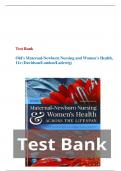Exam (elaborations)
Test Bank For Old's Maternal-Newborn Nursing and Women's Health, 11e (Davidson/London/Ladewig Complete Solution A GRADE
Course
Old\'s Maternal-Newborn Nursing and Women\'s Health,
Institution
Old\'s Maternal-Newborn Nursing And Women\'s Health,
Test Bank
Old's Maternal-Newborn Nursing and Women's Health, 11e (Davidson/London/Ladewig
Test Bank For Old's Maternal-Newborn Nursing and Women's Health, 11e (Davidson/London/Ladewig Complete Solution A GRADTest Bank For Old's Maternal-Newborn Nursing and Women's Health, 11e (Davidson/Londo...
[Show more]
Preview 4 out of 1282 pages
Uploaded on
August 24, 2024
Number of pages
1282
Written in
2024/2025
Type
Exam (elaborations)
Contains
Questions & answers
Institution
Old's Maternal-Newborn Nursing and Women's Health,
Course
Old's Maternal-Newborn Nursing and Women's Health,
$15.99
100% satisfaction guarantee
Immediately available after payment
Both online and in PDF
No strings attached
Test Bank




